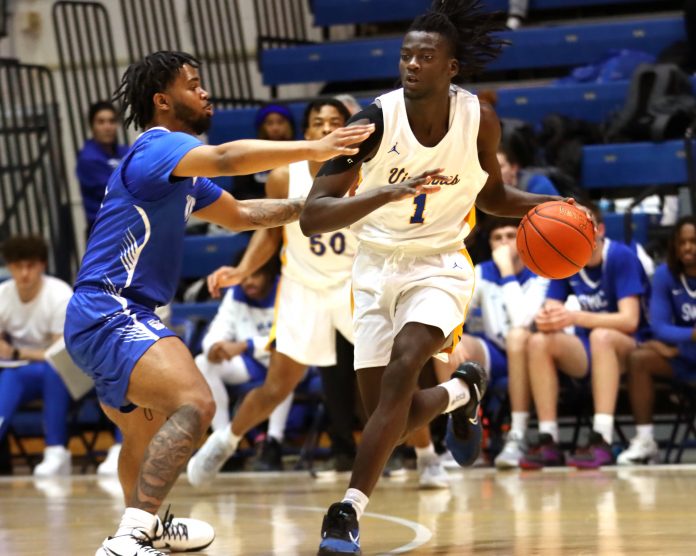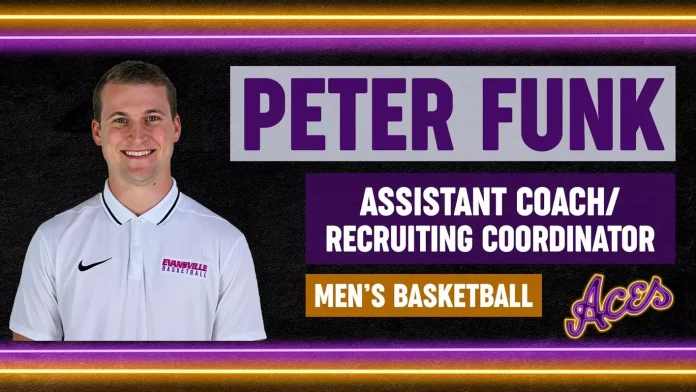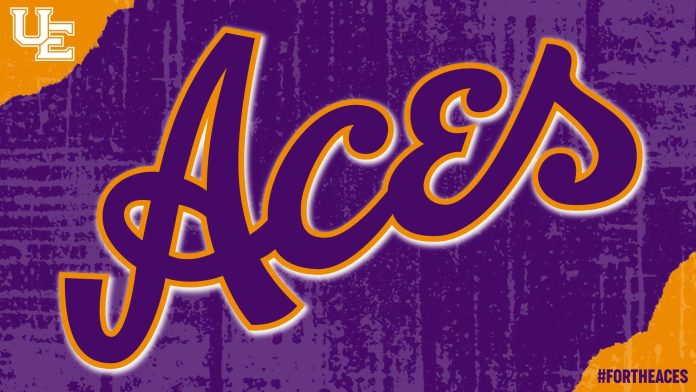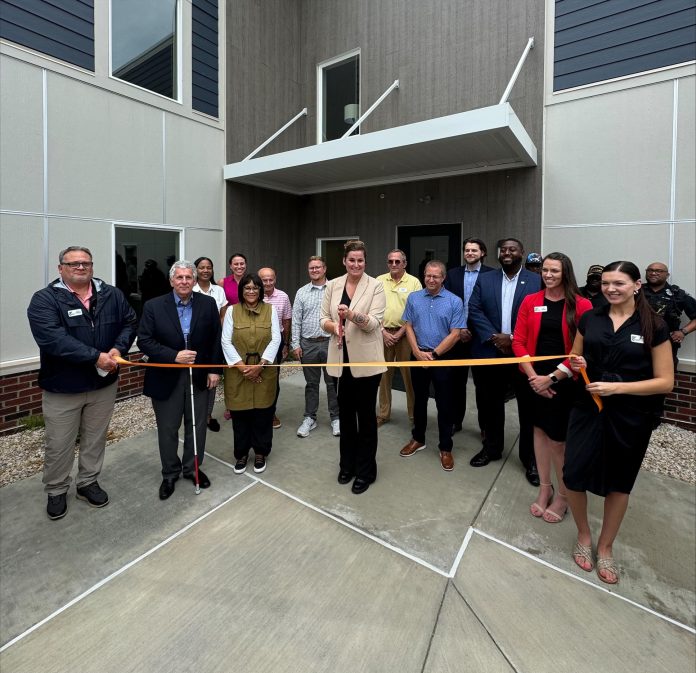Joel Zimba named Executive Deputy AD for External Relations for UE Athletics
Zimba brings a wide range of athletics experience to the Purple Aces
EVANSVILLE, Ind. – University of Evansville Director of Athletics Dr. Kenneth “Ziggy” Siegfried has announced the hiring of Joel Zimba as the Executive Deputy Athletics Director for External Relations. Zimba joins the Purple Aces following a 5-year stint as the District Director of Athletics & Activities at Verona (Wisc.) Area School District.
“We are excited to welcome Joel Zimba and his family to Evansville. Joel is a leader with infectious energy, values teamwork and relationships, and understands the big picture,” Siegfried exclaimed. “His experience as a District Athletics Director for the last five years will serve him well in this important role for UE Athletics.”
In his time at Verona, Zimba spearheaded all facets of developing, implementing, and improving school athletics programs and events. One of the main highlights of his tenure was his work in orchestrating a large-scale capital project that included the building of a new high school. The project, which included a voter approval of $183M referenda, saw him monitor the construction of a competition pool, cross country course, field house, all exterior fields (baseball, soccer, football, and lacrosse) along with facilities for wrestling, gymnastics, weight, and cardio.
“I humbly thank Dr. Ziggy Siegfried and President (Christopher M.) Pietruszkiewicz for the opportunity to become the Executive Deputy Athletics Director for External Relations at the University of Evansville,” Zimba said. “Ziggy has transformed UE into one of the premier athletic departments in the country and, more importantly, has created a culture built on enthusiasm, hard work, and integrity.”
“I am truly blessed to be joining UE at a time of such positive momentum. I am eagerly looking forward to serving our outstanding student-athletes alongside our incredible coaches and staff and contributing to providing an exceptional student-athlete experience,” Zimba added. “My family is excited to embrace the UE spirit and become part of this vibrant community. Go Purple Aces!”
Along with the new facilities, Zimba had a hands-on approach in multiple facets within the district. He encouraged all students to participate in athletics by executing programming for over 25 sports and more than 50 club teams. He directly supervised, evaluated, and professionally developed more than 120 employees district-wide including coaches, administrators, and support staff.
His work resulted in the creation of four part-time District administrative athletic positions, which enhanced the vision, mission, and initiatives. Zimba negotiated a district-wide co-curricular compensation increase of 12% to recruit, retain, and develop talented coaches and staff.
Prior to assuming his role at Verona Area School District, Zimba held three positions at Valparaiso University between 2015 and 2019. While working towards his Master’s, Zimba served as a Men’s Basketball Graduate Assistant from 2015-16 where he completed planning, managerial, and administrative duties for the men’s basketball program.
He was elevated to the Director of Men’s Basketball Operations at Valpo in 2016 and held that position until 2018. Zimba’s responsibilities in that position included budget administration, facility supervision, equipment inventory control, team travel coordination, development of the practice schedule, and summer camp management.
Zimba’s final year at Valparaiso saw him serve as the Assistant Director of Annual Giving where he played a pivotal role in sourcing and soliciting annual gift commitments up to $10K. He supported the President Circle and accomplished a goal of 125 new donors while helping senior executives raise over $700K from over 2,000 donors.
In 2016, he earned his Master’s of Science in Sports Administration from Valparaiso while earning a Bachelor of Letters & Science in Afro-American Studies Intergroup Relations from the University of Wisconsin-Madison in 2011. Joel and wife Krystin have a four-year-old son – Tayden.
WHAT THEY ARE SAYING…
Dr. Treymane Clardy, Verona Area School District – Superintendent
“Joel Zimba has been a cornerstone of our community, exemplifying academic and athletic excellence throughout his tenure as our Athletic Director in the Verona Area School District. His unwavering commitment to sportsmanship, ethics, and service to others has profoundly influenced our student-athletes and the broader community. We are immensely proud of his achievements and wish him continued success in his new role as Executive Deputy Athletic Director for External Relations at the University of Evansville.”
Chad Wiese, Verona Area School District – Deputy Superintendent
“Joel Zimba is a huge loss for our school district. His work ethic, technical abilities, and, most of all, his interpersonal skills will be greatly missed. Joel’s time in the Verona Area School District resulted in historic achievements and participation rates in our athletic programs. I wish him the best as the Executive Deputy Director for External Relations. Joel’s hire at the University of Evansville will make an immediate impact. I’m confident great things lie ahead.”
David Ragland, University of Evansville – Head Men’s Basketball Coach
“I met Joel 8 years ago and had the honor of working with him for two years at Valparaiso University. I had the opportunity to watch how passionate he is about the student-athlete experience. Joel is selfless and a tireless worker. He is honest and will do what is right no matter the situation. Joel embodies all the qualities of the culture Dr Ziggy Siegfried has worked so hard to create for our athletic department here at UE. Dr Ziggy Siegfried has created great momentum within our athletic department, built on positivity, problem-solving, and connectivity through effective communication. I’m excited to watch our athletics department improve with Joel Zimba’s addition and look forward to working alongside him.”
Steve Watson, Loyola Chicago – Director of Athletics
“Evansville is getting one of the best in Joel Zimba. With his background and experience in athletics administration, there’s no doubt he’ll do great things for the Purple Aces. Congratulations to Ziggy and his staff for landing a good one!”
Jackie Manuel, American University – Assistant Men’s Basketball Coach
“Joel Zimba is a great friend and person. Joel is a hard worker and consummate professional who strives to serve others every day. EU is getting a high-character person that is committed to excellence.”
Jamie Sims, Middleton-Cross Plains Area School District – District Director of Athletics and Activities
“I had the great pleasure to meet and begin working with Joel Zimba in 2020 as an athletic director, and since then, I have had the opportunity to partner with and create a meaningful relationship that surpasses the world of education-based athletics. Mr. Zimba’s leadership skills and ability to get the best out of the most as a part of his character, leadership, and overall care and concern for others continue to inspire and motivate me to do precisely that in my current capacity. Joel’s passion for leading others and ensuring equitable outcomes for all has resonated with me and overflowed into the Big 8 conference here in Wisconsin. Today, I am a better leader because I have met and worked alongside Joel Zimba. He has definitely left his life, print, and legacy in Wisconsin Interscholastic Athletics.










